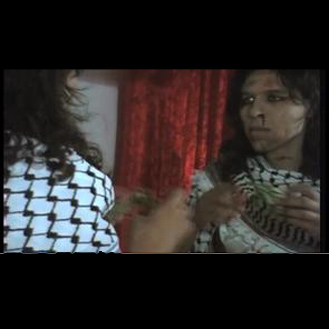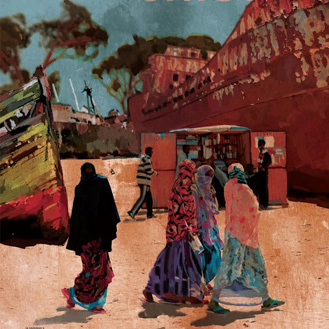Domenica 20 H19
TOPOGRAPHIXX: Trans in the landscape
Un programma internazionale di video arte che si occupa di paesaggio, frontiera, zona e territorio, in un ambito transgender.
Curato da Tobaron Waxman. Introduzione di Francesco Macarone Palmieri aka Warbear
1.Chris Vargas (USA)
Have you ever seen a transsexual before? _ 2010 (04 min)
“La prima metà del video registra una guerriglia e, attraverso la ripetizione, diventa una dichiarazione e una campagna di visibilità per Transessuali FTM(Female-To-Male). Quando la campagna si dimostra inutile, io entro in un un magico mondo animato, dove osservo e sono confortato da una fauna colorata e appariscente. Dedicato all’amico Sam Lopes.” – Chris Vargas.
2. Barbara de Genevieve (Chicago)
Out of the Woods _ (08 min)
Una scena di sesso nel bosco tra FTM (Female-To-Male) e MTF (Male To Female), girato durante il Camp Trans.
Vincitore del Paris Post Porn Film Festival Award 2011.
3. Del LaGrace Volcano (London/Stockhölm)
The Passionate Spectator
_ 2004 (10 min)
Un’apparizione genderqueer elegantemente agghindata attraversa un paesaggio urbano Europeo. Ispirato da Baudelaire e dall’ultimo Brixton Brady, questo corto incarna la magia del “Flaneur”, che “vede ma non compra” e si ritrova in continuo movimento attraverso confini che lui/lei rifiuta di riconoscere. (nota: sia BriXton Brady che Del LaGrace sono identificati come ermafroditi, questo potrebbe essere il primo esempio di film non-narrativo di “cinema intersessuale”).
4. Raafat Hattab (Jaffa)
Bidun Unwaan _ (06 min)
Nella maggior parte del suo lavoro, Raafat si esibisce in una figura non tradizionale di drag come “Arouse Falastin” (La sposa della Palestina, عروس فلسطين). La sposa della Palestina fa riferimento nella cultura storico-tradizionale Palestinese all’antica città-porto di Jaffa. In ‘Bidun Unwaan’ (untitled), il ritornello della colonna sonora canta “Lascio questo posto” e in arabo il titolo della stessa, vuol dire anche “Senza indirizzo di posta”. L’albero di ulivo, simbolo del villaggio Palestinese, e Raafat, amorevole balia dell’albero, sono le due figure che non lasceranno mai quel luogo. Ma quando la camera allarga l’inquadratura, si svela che il contesto di questa scena di amorevole coltivazione non è altro che Rabin Square in Tel Aviv, e la sorgente dell’acqua è la fontana nei pressi del Municipio al centro della più grande città Sionista.
Raafat Hattab: “Per me, l’albero che rappresenta l’identità Palestinese, si trova in un luogo che prima era Palestina, la sua terra originaria, e adesso, è piantato in un luogo confinato che non è un uliveto; è isolato. Rappresenta me, è cosi che mi sento”.
5. Mirha Soleil Ross (Quebec) _ 2002 (13 min)
Allo performance _ 2002 (13 min)
Da Maggio 2001 a Febbraio 2002, l’artista Mirha-Soleil Ross, una donna trans, come parte del suo progetto “The Pregnancy Project” (Il Progetto Gravidanza) nei 9 mesi di durata del di questo ciclo di progetto è apparsa in pubblico sempre mostrandosi incinta. Il vestito apparentemente innocente che appare in questo video montato con molta cura è ispirato da Shulmit Firestone.
“Mia madre non ha mai utilizzato termini spirituali per parlare di Cristianità. In questo video lei usa parole, che per me, vanno oltre le culture e, che sono strettamente legate a una cultura Aborigena che viene da una religione convertita antica di 500 anni, l’Anusian (Gli Anushim sono dei cripto-ebrei che furono costretti a convertirsi in Spagna e Portogallo e che fuggirono per essere i primi stabilire nella New France). La sua spiritualità si sviluppa ijn termini di “destino” e in questo senso è estremamente “aborigeno”. Queste, sono cose che la maggior parte della gente sicuramente non comprende, ma a noi poco importa. La maggior parte del contenuto vuole interpretare e codificare il senso identitario della donna. Alla fine del video cado nell’acqua, crollo, mi abbandono nell’acqua per essere una donna capace di riprodurre, sia il suo essere ebrea che aborigena in un territorio straniero”- Mirha Soleil Ross
6. Raafat Hattab (Jaffa)
Houria _ (07 min)
In “Houria” (Sirena/Libertà), Hattab intervista Yousra, sua zia, che gli racconta una serie di storie tramandate, che parlano dei luoghi in cui la sua famiglia ha vissuto, e dove si è dispersa nel 1948. L’immagine delle sue storie si sovrappone alla fantasia di Hattab di essere travestito da sirena sulla costa di Al-Manshiyeh, il quartiere dei nord palestinesi che confina con il mare e Tel Aviv. Hattab, che è genderqueer, è perennemente in bilico fra due mondi, non diversamente dalla sirena spiaggiata.
7. Rémy Huberdeau (Canada)
Au pays des esprits (Home of the Buffalo) _ 2009
(04:26 min)
Costruito da immagini d’archivio di praterie canadesi, scattate fra il 1920 e il 1940, questo film esplora, in maniera del tutto poetica, la relazione di un/a figlio/a, con suo padre, e quelle della famiglia con la propria terra.
8. Yossi Yacov (Berlin/Tel Aviv)
The National Erection _ 2007 (04 min)
Riferendosi ad un monumento storico di un cannone del 1948, gli Attivisti queer costruiscono un pene-cannone gigante, rosa, per spruzzare mastodontiche eiaculazioni sui monumenti militari e sionisti di Tel Aviv, come gesto di protesta, così travestendo l’etica nazionale in un pene spruzzante di raso rosa. I residenti raccontano che la polizia si sentì incastrata? Allineata? Gelosa? Comunque abbastanza per distruggere a randellate “l’erezione nazionale”, castrando il fallo queer, in risposta all’attivismo perverso del paesaggio del mito nazionalista.
9. Jacolby Satterwhite (USA)
Reifying Desire _ 2011 (7min)
Animazione 3d/Video Digitale. La Storia del Mito della Creazione Queer basata su disegni e accompagnamenti vocali della madre dell’artista. Jacolby descriveva “”Reifying Desire” : “per me è un paesaggio psicosessuale queer non senziente, costruito dai disegni di una schizofrenica, e dalle riconfigurazioni di suo figlio che riutilizza il materiale da lei disegnato.” E continuava definendo ‘Queer’ come “la diversità di chi è al di fuori della normatività”.
tobaron.com
Sunday H19
TOPOGRAPHIXX: Trans in the landscape
An international program of video art concerned with landscape, border, zone and territory, in a transgender spectrum
Curated by Tobaron Waxman. Introduction by Francesco Macarone Palmieri aka Warbear
1.Chris Vargas (USA)
Have you ever seen a transsexual before? _ 2010 (04 min)
“The first half of the video records a guerilla performance, and through repetition, becomes a declaration and a campaign for Female-To-Male (FTM) transsexual visibility. When the campaign proves futile I enter a magical animated world where I observe and am greeted by colorful and flamboyant wildlife. Dedicated to friend Sam Lopes.” – Chris Vargas
2. Barbara de Genevieve (Chicago)
Out of the Woods _ (08 min)
Una scena di sesso nel bosco tra FTM (Female-To-Male) e MTF (Male To Female), girato durante il Camp Trans.
Vincitore del Paris Post Porn Film Festival Award 2010.
3. Del LaGrace Volcano (London/Stockhölm)
The Passionate Spectator
_ 2004 (10 min)
An elegantly costumed genderqueer apparition traverses a European urban landscape. Inspired by Baudelaire and the late Brixton Brady,
this short embodies the magic of the flaneur who
sees but does not buy, who is in constant movement across borders which s/he refuses to recognize.
(note: both the late BriXton Brady and Del are ‘herm’ identified. This film may be the first non-narrative example of an ‘intersex cinema’.)
4. Raafat Hattab (Jaffa)
Bidun Unwaan _ (06 min)
In much of his work, Raafat performs in a non-traditional drag as ‘Arouse Falastin’ (The Bride of Palestine) عروس فلسطين. The Bride of Palestine is a traditional Palestinian reference to the ancient port city of Jaffa. In ‘Bidun Unwaan’ (untitled) the refrain of the soundtrack is “I leave the place”, and in Arabic the title also means ‘without mailing address’. As the loving caregiver to the tree, both Raafat and the olive tree as symbol for the Palestinian village are two figures who have never left the place. When the camera zooms out, the context for this nurturing is revealed to actually be in the middle of Tel Aviv’s Rabin Square, and the source of the water is the fountain pool by City Hall, at the centre of Zionism’s largest city.
Raafat Hattab: “For me, the tree that represents my Palestinian identity, is planted in a place that, on one hand, it was Palestine, the original land of it. And now it’s planted in a place that is framed, so its not its natural place, its not an olive grove and it’s lonely. It represents me, that’s how I feel.”
5. Mirha Soleil Ross (Quebec) _ 2002 (13 min)
Allo performance _ 2002 (13 min)
From May 2001 to February 2002, artist Mirha-Soleil Ross, who is a trans woman, appeared pregnant every time she was in public as part of her 9 month long performance art cycle “The Pregnancy Project”. Ross’ seemingly innocuous dress is inspired by Shulamit Firestone, in this carefully layered performance video. “My mother never used spiritual terms related to Christianity. In this video she uses words that to me, go across culture and are related to Aborginal Culture, and come from 500 years of old, converted Anusian religion (Anushim are crypto-Jews forced to convert in Portugal and Spain who escaped to be early settlers of New France.) Her spirituality is in terms of ‘destiny’ and that is very Aboriginal. Those are things that most people wouldn’t understand, but we didn’t care. So much of the content is to render and recodify a sense of who the woman is. At the end of the video I fall in the water, I collapse, I fail in the water, to be a woman who can reproduce, can reproduce either Jewishness or Aboriginalness, on foreign territory.” – Mirha Soleil Ross
6. Raafat Hattab (Jaffa)
Houria _ (07 min)
In “Houria” (Mermaid/Freedom), Hattab interviews Yousra, his aunt, who tells him generations of stories she has inherited, about where they lived, and where parts of the family dispersed to in 1948. The image of her storytelling is interwoven with imagery of Hattab dressed as a mermaid on the shore of Al-Manshiyeh, the northern Palestinian neighbourhood that borders the sea and Tel Aviv. Hattab, who ID’s as (what is in English codified as) genderqueer, is perpetually between contexts, not unlike the beached mermaid.
7. Rémy Huberdeau (Canada)
Au pays des esprits (Home of the Buffalo) _ 2009
(04:26 min)
Constructed from Canadian prairie archival images taken between 1920 and 1940, this film lyrically explores a son/daughter’s relationship with his/her father and the family’s relationship to their land.
8. Yossi Yacov (Berlin/Tel Aviv)
The National Erection _ 2007 (04 min)
Referencing a historic cannon-monument from 1948, Queer activists create a giant pink cannon-cock, to squirt giant cumshots on Tel Aviv’s military and Zionist monuments as a protest gesture, thus ‘dragging’ the national ethos as a squirting pink satin penis. Locals report that the police felt compelled? justified? jealous? enough to destroy the ‘national erection’ with clubs, castrating the queer phallus, in response to the activists perversion of the landscape of national myth.
9. Jacolby Satterwhite (USA)
Reifying Desire _ 2011 (7min)
3D animation / Digital Video. A Queer Creation Myth Story based on the artist’s mother’s drawings and vocals. Jacolby described “Reifying Desire” to me as a “queer, non sensical, psychosexual landscape….built from drawings made by a schizophrenic, and her son vogues around the material culture she drew.” He went on to define ‘Queer’ as “queer in the definition of outside of normativity”.








